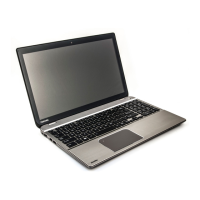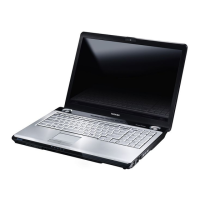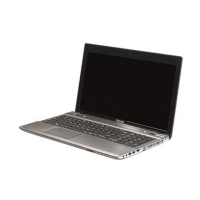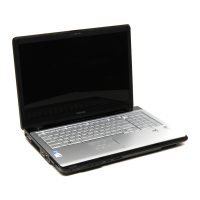
Do you have a question about the Toshiba Satellite P100 Series and is the answer not in the manual?
| Processor | Intel Core 2 Duo |
|---|---|
| Optical Drive | DVD SuperMulti Drive (DVD±RW/CD-RW) |
| Operating System | Windows Vista or XP |
| Chipset | Intel 945PM Express |
| Wireless | Wi-Fi 802.11a/b/g |
| Battery | Lithium-ion battery pack |
| Display | 17-inch WXGA |
Legal information regarding copyright and usage rights.
Legal statement about the manual's accuracy and liability.
States compliance with FCC rules for digital devices.
Lists FCC compliance conditions.
States compliance with European Directives.
Details Canadian regulatory compliance for digital apparatus.
Warning about modem usage and modifications.
Requirement to select Japan region mode for modem use.
Information required for modem installation and connection.
Safety precautions for optical disc drives.
Safety warnings for DVD Super Multi drives.
General safety precautions for laser products.
Warnings about stress, heat, and impact damage.
Warnings on PC Card heat, phone interference, and CPU performance.
Guidance on CE marks and approved environments.
Wireless LAN safety and limitation of liability.
Overview of the manual's chapters, appendices, glossary, and index.
Overview of computer's special features.
Identification of computer components.
Basic information for starting computer operation.
Instructions for computer operations.
Keyboard functions and hotkeys.
Computer's power resources and modes.
Introduction to hardware setup program.
Description of available optional hardware.
Information on solving computer problems.
Technical specifications of the computer.
Display modes for external monitors.
Wireless LAN card specifications.
AC power cord specifications.
Definitions of computer terminology.
Formats and definitions used in the manual.
Identification and operation of keys.
How display elements and messages are presented.
Items included with the computer.
List of computer's documentation.
Details on supported Intel processors.
Information on chipsets and memory.
Battery, AC adapter, and TouchPad.
Details on the computer's TFT display.
Information on hard disk and optical disc drives.
PC Card, ExpressCard, and media card slots.
VGA, USB, DVI, TV Out, sound system.
Modem, LAN, Wireless LAN, passwords.
Unique or advanced features.
Keyboard shortcuts and password security.
Data security and display power management.
HDD power off, auto standby/hibernation.
Description of preinstalled utilities.
Details on Zooming Utility, RecordNow!, etc.
Addable options like memory, battery packs.
Computer's front with display closed.
Jacks, slots, and switches on the front panel.
Optical drive, USB ports, eject buttons.
USB, i.LINK, PC Card, ExpressCard slots.
Security lock, USB, VGA, DVI, TV Out, LAN, Modem jacks.
LAN, Modem jacks, hard drive bay.
Battery, memory slots, drive bays.
Computer's front with display open and LEDs.
LEDs, Power, Internet buttons.
CD/DVD buttons, playback controls.
Lock indicators, TouchPad buttons.
Features enabled by fingerprint recognition.
Information on installed optical disc drives.
Mapping DVD region codes to countries/regions.
Description of CD-R and CD-RW writable disc types.
Specifications for DVD drives.
Functionality and usage of the AC adapter.
Advice on creating a comfortable and safe work site.
Guidelines for proper work site environment and ventilation.
Recommendations for positioning computer for comfort and safety.
Importance of chair height and body support for reducing work strain.
Tips for proper lighting to improve display legibility and reduce eye strain.
Advice on varying activities to avoid discomfort and improve efficiency.
Steps for connecting the AC adapter to charge the battery.
Instructions for opening the computer's display panel.
Steps for powering on and initial setup procedures.
Procedures for shutting down, hibernating, or standby modes.
Steps to enter and manage hibernation modes.
How the computer enters sleep mode while power remains on.
Methods for resetting the computer system.
Steps to create a recovery CD for Express Media Player.
Instructions for using the TouchPad and its buttons.
Functionality of each button on the Dual Pad.
Purpose and functions enabled by the fingerprint utility.
Guidelines to avoid sensor damage and improve recognition.
Utility notes, backup advice, and limitations.
Procedure for initial fingerprint authentication setup.
Using fingerprint authentication for Windows logon.
Using fingerprint system to replace keyboard/BIOS password authentication.
Single fingerprint authentication for multiple passwords.
Steps for swiping fingers for registration or authentication.
How to make settings and connect the internal modem.
Modem properties menu, selection, and connection steps.
Information on connecting and disconnecting to a LAN.
Compatibility and features of Wireless LAN.
Factors affecting wireless LAN transmission speed and range.
Need for cables and features of Bluetooth technology.
LED indicators and optical disc drive operation.
Steps for loading a disc into the drive.
Steps for removing discs and button assignments.
Quick play feature for DVD and CD playback.
Controlling software and media files with the remote control.
Using drives to write data to CD-R/RW discs.
Points to observe when writing or rewriting data.
Actions to note or avoid when writing or rewriting discs.
Tips for protecting data on discs and diskettes.
How to utilize multiple displays for an extended desktop.
Steps for cleaning and moving the computer safely.
Produces letters, numbers, and symbols on screen.
Keys that execute programmed functions when pressed.
Key combinations that enable/disable specific features.
Keyboard shortcuts for system functions like volume and standby.
Keys with special functions in Windows, like Start menu.
Features of the full-sized built-in keyboard.
How to generate characters using ASCII codes.
Computer's operating capability based on power status.
Battery, DC IN, and Power indicators for system status.
Lights indicating battery status (low, charging, full).
Indicators for AC adapter and computer power status.
Types of batteries used in the computer.
Main power source, removable lithium ion battery.
Battery powering the internal clock and calendar.
Instructions for safe operation and maximum performance of battery pack.
Advisories regarding hazardous situations with batteries.
Process and indicators for charging the computer's batteries.
Charging time, conditions affecting charging, and recommendations.
Monitoring capacity and tips to maximize battery operating time.
When and how to install a new battery pack.
Steps to remove a discharged battery pack.
Steps to install a new battery pack into the computer.
Utility for setting user and supervisor passwords.
Manually entering password to start the computer.
Overview of Hibernation, Standby, and Boot power-up modes.
Feature to turn power off/on with display panel action.
Automatic system shutdown in Standby or Hibernation mode.
How to use TOSHIBA HW Setup to configure computer settings.
Overview of HW Setup window tabs and buttons.
Displays BIOS version and contains Default/About buttons.
Setting user passwords and customizing display settings.
Use display when computer is booted in Standard VGA mode.
Option to set priority for booting the computer.
Settings for wake-up on keyboard and legacy USB support.
Settings to enable or disable the Built-in LAN function.
Lists PC cards, ExpressCard, memory cards, and modules.
Lists battery pack and AC adapter as power devices.
Lists external monitor, television, i.LINK, and security lock.
PC Card slot information and installation/removal steps.
ExpressCard slot information and installation/removal steps.
Information on memory card slot and card handling.
How to install additional RAM modules.
Steps for removing a memory module from the computer.
Increasing portability with extra battery packs and AC adapters.
Connecting external monitors and TVs to the computer.
Steps for connecting i.LINK devices.
Anchoring computer to desk to prevent unauthorized removal.
Guidelines for resolving problems effectively.
Simple solutions to fix common issues.
Questions to help identify the cause of malfunctions.
Checklist of hardware and peripheral problems.
Items to check when the computer does not start properly.
Automatic test and checklists for power-related problems.
Troubleshooting AC adapter issues.
Troubleshooting battery power and charging issues.
Troubleshooting keyboard and LCD panel problems.
Troubleshooting hard disk drive issues like slow performance.
Troubleshooting issues related to entering passwords.
Troubleshooting issues with accessing discs or writing.
Troubleshooting issues with diskette, PC card, and memory card.
Troubleshooting sound and TouchPad pointer problems.
Troubleshooting USB mouse and fingerprint recognition failures.
Troubleshooting USB device and TV output problems.
Troubleshooting system standby/hibernation and RTC errors.
Troubleshooting memory installation and modem communication.
Troubleshooting LAN access and Wireless LAN connection.
Troubleshooting Bluetooth device and monitor problems.
Troubleshooting i.LINK device issues and contacting support.
TOSHIBA contact addresses for hardware-related problems.
Physical dimensions of the computer.
Operating and non-operating environmental conditions.
Technical specifications for the internal modem.
Display modes for external monitors via VGA port.
Display modes for external monitors via DVI port.
Setting up simultaneous display on LCD and external monitor.
Form factor, compatibility, OS, and data rate of Wireless LAN cards.
Factors affecting wireless communication characteristics.
Wireless LAN channel sets for 2.4GHz and 5GHz bands.
Power cord length, wire size, current, and voltage ratings.
List of certification agencies for various countries.
Illustrations of plug shapes for USA, Canada, UK, Australia, Europe.
List of abbreviations used in the manual.
Definitions starting with 'A', 'B', and 'C'.
Definitions starting with 'D', 'E', and 'F'.
Definitions starting with 'G', 'H', 'I', 'J', 'K', 'L', 'M'.
Definitions starting with 'N', 'O', 'P', and 'R'.
Definitions starting with 'S', 'T', 'U', 'V', and 'W'.
Alphabetical index entries from A to F.
Alphabetical index entries from H to M.
Alphabetical index entries from P to W.











